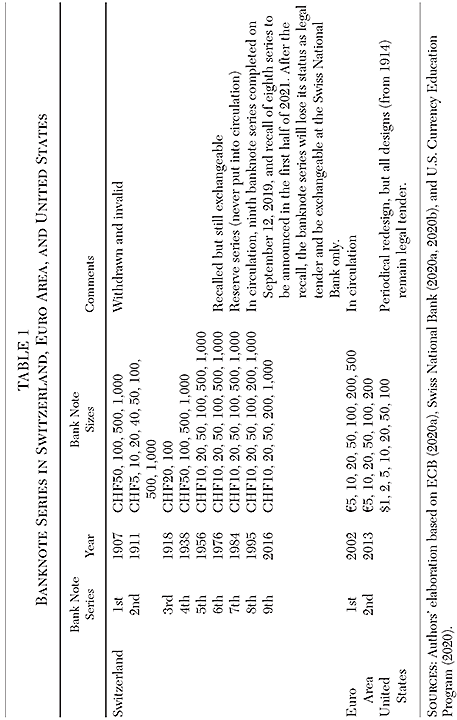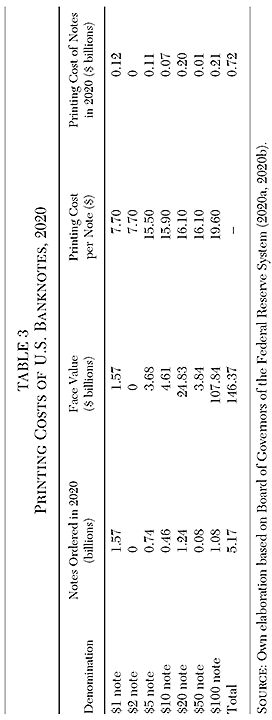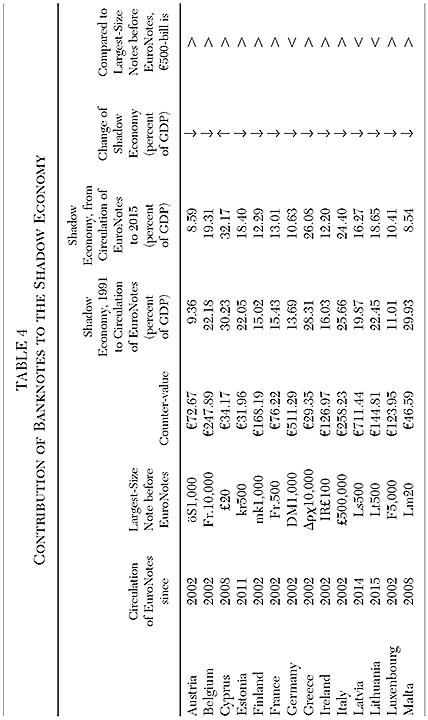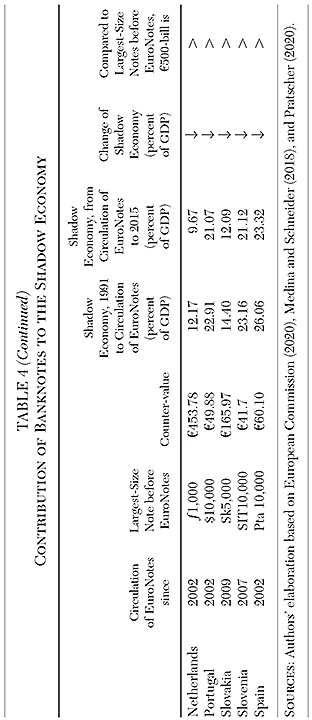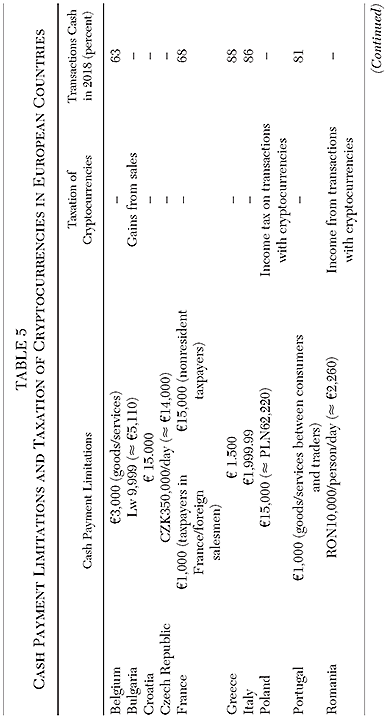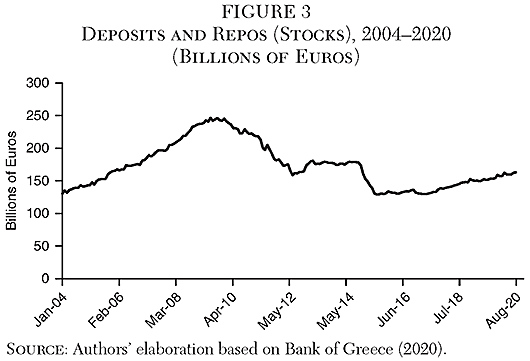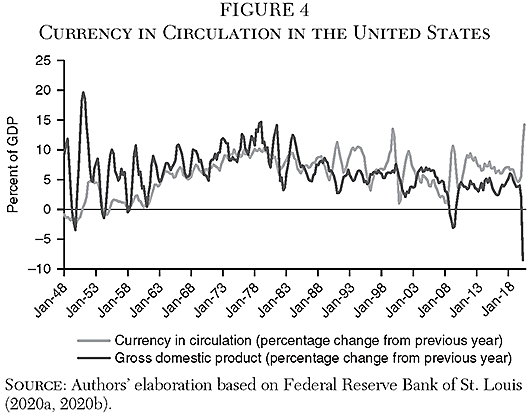Conclusion
We conclude that institutional hostility to cash has been accelerated by great shocks, beginning with the 2008 financial crisis and continuing with the current pandemic. However, the narratives of both the private financial sector and governments about the disadvantages of paying with cash or using large banknotes are partly flawed.
Eliminating cash would not only increase financial instability and market power of the financial sector, but also lead to financial exclusion and social discrimination with severe adverse effects on the vulnerable (Dowd 2019a: 394–95), adding to the impact of the pandemic on inequality (Stiglitz 2020). According to Access to Cash Review (2019: 6), “around 17 percent of the UK population—over 8 million adults—would struggle to cope in a cashless society. . . . For a start, poverty is the biggest indicator of cash dependency, not age.” The pandemic has set in motion a major economic downturn—the International Monetary Fund (2020b) forecasts a drop in world output by 4.4 percent—and banks are likely to adopt more conservative lending policies (Goodell 2020). Among the most penalized subjects are “the unbanked” (King 2014) and “the underbanked” having “limited access to services” (Wherry and Schor 2015: 174).
Like every disaster, the pandemic is a magnifier and intensifier of social discrimination (Klein 2020b). By accelerating digitalization—retail sales via mail order houses or the internet have soared in the European Union from 166.4 (March 2020) to 185.2 (September 2020) with 2015=100 (Eurostat 2020)—it uncovers the lack of access to the internet or insufficient digital literacy of social groups. This divide also concerns access to financial services in advanced countries where bank branches are closed to increase cost efficiency (Conrad et al. 2019). Combined with lockdowns, this trend will have a negative impact on physical retail stores, which are already struggling to cope with digital (i.e., 24-hours-a-day-running) competitors. At the same time, a cash-free commerce obliterates people’s privacy and entrenches racial and gender discrimination. In fact, “any person or company with access to the bank statement of the consumer can learn a lot of information about his/her financial and personal life by analyzing their payment transactions” (Bureau Européen des Unions des Consommateurs, AISBL 2019: 14).
Covid-19 should not become a war on cash, because there is no need to create tension between cashless and physical means of payments. In fact, both have proven to be useful depending on the situation while banknotes and coins are also stores of value. This is something not replaceable in gold-detached systems whose “anchor of stability” is (physical) cash.
References
Access to Cash Review (2019) “Final Report, March 2019.” Available at www.accesstocash.org.uk/media/1087/final-report-final-web.pdf.
Amazon.com (2020) “Press Release: Amazon.com Announces Third Quarter Results (October 29).” Available at press.aboutamazon.com/news-releases/news-release-details/amazoncom-announces-third-quarter-results.
Ashworth, J., and Goodhart, C. (2020) “Coronavirus Panic Fuels a Surge in Cash Demand.” Available at voxeu.org/article/coronavirus-panic-fuels-surge-cash-demand.
Aydogan, S., and Van Hove, L. (2015) “Nudging Consumers towards Card Payments: A Field Experiment.” In Deutsche Bundesbank (ed.), The Usage, Costs and Benefits of Cash Revisited. Frankfurt am Main: Deutsche Bundesbank.
Bank of England (2020) “Questions about Guidelines for Handling Old and Mutilated Banknotes during the Covid-19 Pandemic.” Available at www.bankofengland.co.uk/freedom-of-information/2020/questions-about-guidelines-handling-old-and-mutilated-banknotes-covid-19-pandemic.
Bank of Greece (2020) “Deposits and Repos of Non MFIs in MFIs in Greece (Excluding the Bank of Greece)—Outstanding Amounts at End of Period.” Available at opendata.bankofgreece.gr/datasetFile.ashx?fileName=BoG_DepositStock_en_2020-08–27.xls&folderName=STATISTIKI.
Belke, A., and Beretta, E. (2020a) “From Cash to Central Bank Digital Currencies and Cryptocurrencies: A Balancing Act between Modernity and Monetary Stability.” Journal of Economic Studies 47 (4): 911–38.
__________ (2020b) “From Cash to Private and Public Digital Currencies: The Risk of Financial Instability and ‘Modern Monetary Middle Ages.’” Economics and Business Letters 9 (3): 189–96.
__________ (2020c) “Not the Time for Central Bank Digital Currency: Why Cash Is Still Irreplaceable.” Credit and Capital Markets/Kredit und Kapital 53 (2): 147–58.
Beretta, E. (2007) “Cash Restrictions, Alias the EU’s Brake on Growth: New Analytical and Empirical Evidence.” Currency News 15 (7): 7.
__________ (2015) “Europe’s New but Wrong Approach to Cash.” Currency News 13 (4): 5–8.
Bergsten, F. (1996) Dilemmas of the Dollar: the Economics and Politics of United States International Monetary Policy. 2nd ed. New York: Council on Foreign Relations.
Board of Governors of the Federal Reserve System (2020a) “Currency and Coin Services: 2020 Federal Reserve Note Print Order.” Available at www.federalreserve.gov/paymentsystems/2020_currency_print_orders.htm.
__________ (2020b) “FAQs—How Much Does It Cost to Produce Currency and Coin?” Available at www.federalreserve.gov/faqs/currency_12771.htm.
Britannica (2020) “Credit Card.” Available at www.britannica.com/topic/credit-card.
Brunnermeier, M. K., and Niepelt, D. (2019) “On the Equivalence of Private and Public Money.” Journal of Monetary Economics 106: 27–41.
Bureau Européen des Unions des Consommateurs, AISBL (2019) “Cash versus Cashless. Consumers Need a Right to Use Cash.” Available at www.beuc.eu/publications/beuc-x-2019–052_cash_versus_cashless.pdf.
Carter, D. A., and Simkins, B. J. (2004) “The Market’s Reaction to Unexpected, Catastrophic Events: The Case of Airline Stock Returns and the September 11th Attacks.” Quarterly Review of Economics and Finance 44: 539–58.
Cencini, A. (2002) Monetary Theory: National and International. New York: Routledge.
__________ (2005) Macroeconomic Foundations of Macroeconomics. New York: Routledge.
Central Bank of Kenya (2019) “Press Release: Conclusion of Demonetization Exercise.” Available at www.centralbank.go.ke/uploads/press_releases/735017284_Press%20Release%20-%20Conclusion%20of%20Demonetisation%20Exercise.pdf.
Committee on Payments and Market Infrastructures (2020) “Final Settlement.” Available at www.bis.org/cpmi/publ/d00b.htm?&selection=30&scope=CPMI&c=a&base=term.
Commonwealth Scientific and Industrial Research Organisation (2020) “CSIRO Scientists Publish New Research on SARS-COV‑2 Virus ‘Survivability.’” Available at www.csiro.au/en/News/News-releases/2020/CSIRO-scientists-publish-new-research-on-SARS-COV-2-virus-survivability.
Conrad, A.; Neuberger, D.; Peters, F.; and Rösch, F. (2019) The Impact of Socio-economic and Demographic Factors on the Use of Digital Access to Financial Services.” Credit and Capital Markets–Kredit und Kapital 52 (3): 295–321.
CQ Researchers (2019) Global Issues 2020 Edition: Selections from CQ Researcher. Washington: CQ Press.
Das, A., and Basu, K. (2016) S. Chand’s ICSE Economic Applications:Book II for Class X. New Delhi: S. Chand.
Deutsche Bundesbank (2017) International Cash Conference 2017. War on Cash: Is There a Future for Cash? Frankfurt am Main: Deutsche Bundesbank.
Directorate-General for Taxation and Customs Union (2012) “FTT—Additional Analysis of Impacts and Further Clarification of Practical Functioning—4 May 2012.” Available at ec.europa.eu/taxation_customs/sites/taxation/files/docs/body/technical_fiches.pdf.
Dowd, K. (2019a) “The War on Cash Is about Much More than Cash.” Economic Affairs 39: 391–99.
__________ (2019b) “We Mustn’t Lose the War on Cash.” Institute of Economic Affairs blog (November 14).
__________ (2019c) “The War on Cash Is no Use in the War on Crime.” Investment Foresight: Online Business Magazine (December 10).
Draghi, M. (2012) “Verbatim of the Remarks Made by Mario Draghi.” Speech at the Global Investment Conference, London (July 26). Available at www.ecb.europa.eu/press/key/date/2012/html/sp120726.en.html.
Economic Times (2020) “How Cash Turned Suspicious under COVID-19.” Economic Times (May 20).
Egerth, K. (2020) “Cash Is no Longer King in Times of COVID-19: Raining on Cash’s Reign.” Available at www2.deloitte.com/ch/en/pages/consumer-industrial-products/articles/cash-is-no-longer-king-in-times-of-covid19.html.
European Central Bank (ECB) (2020a) “Banknotes.” Available at www.ecb.europa.eu/euro/banknotes/html/index.en.html.
__________ (2020b) “Banknotes and Coins Circulation.” Available at www.ecb.europa.eu/stats/policy_and_exchange_rates/banknotes+coins/circulation/html/index.en.html.
European Commission (2020) “What Is the Euro Area?” Available at ec.europa.eu/info/business-economy-euro/euro-area/what-euro-area_en.
European Consumer Centre France (2020) “Cash Payment Limitations.” Available at www.europe-consommateurs.eu/en/consumer-topics/financial-services-insurance/banking/means-of-payment/cash-payment-limitations.
Eurostat (2020) “Turnover and Volume of Sales in Wholesale and Retail Trade. Monthly Data. Retail Sale via Mail Order Houses or via Internet.” Available at appsso.eurostat.ec.europa.eu/nui/submitViewTableAction.do.
Federal Reserve Bank of St. Louis (2020a) “Currency in Circulation.” Available at fred.stlouisfed.org/series/CURRCIR.
__________ (2020b) “Gross Domestic Product.” Available at fred.stlouisfed.org/series/GDP.
Fetters, A. (2020) “When Keeping Your Distance Is the Best Way to Show You Care.” The Atlantic (March 10).
Financial Times (2015) “The Case for Retiring Another ‘Barbarous Relic.’” Financial Times (August 23).
G4S Global Cash Solutions (2018) “World Cash Report 2018.” Available at cashessentials.org/app/uploads/2018/07/2018-world-cash-report.pdf.
G4S Retail Cash Solutions (2020) “Exceptional Value within G4S.” Available at www.g4s.com.
Goodbaudy, T. (2011) You Don’t Want to Read What This Man Has to Say! Portland: PDXdzyn.
Goodell, J. W. (2020) “COVID-19 and Finance: Agendas for Future Research.” Finance Research Letters 35: 101512.
Huber, J. (2020) “What Is Sovereign Money?” Available at sovereignmoney.site/what-is-sovereign-money.
International Monetary Fund (IMF) (2020a) Annual Report on Exchange Arrangements and Exchange Restrictions 2019. Washington: IMF.
__________ (2020b) “World Economic Outlook Update, October 2020. A Long and Difficult Ascent.” Washington: IMF.
Jain, K. (2017) The War on Cash. Demonetisation. New Delhi: Educreation.
Jon Ashwell Creative (2020) “Cashfree and Proud.” Available at jonashwellcreative.weebly.com/visa-cashfree—proud.html.
King, B. (2014) Breaking Banks: The Innovators, Rogues, and Strategists Rebooting Banking. Singapore: Wiley.
Klein, N. (2020a) “How Big Tech Plans to Profit from the Pandemic.” The Guardian (May 13).
__________ (2020b) “We Must not Return to the Pre-Covid Status Quo, Only Worse.” The Guardian (July 13).
Law Library of Congress (2020) “Regulation of Cryptocurrency around the World.” Available at www.loc.gov/law/help/cryptocurrency/world-survey.php.
Mai, H. (2019) “Cash Empowers the Individual through Data Protection.” Available at www.dbresearch.de.
__________ (2020) “Paying in Times of Crisis: Coronavirus, Cards and Cash.” Available at www.dbresearch.com.
Makortoff, K. (2020) “UK Banks May Have to Flag up Plans to Shut Branches or Cash Machines.” The Guardian (July 16).
Maritz, J. M.; Sullivan, S. A.; Prill, R. J.; Aksoy, E.; Scheid, E.; and Carlton, J. M. (2017) “Filthy Lucre: A Metagenomic Pilot Study of Microbes Found on Circulating Currency in New York City.” PLOS ONE 12 (4): e0175527. Available at https://doi.org/10.1371/journal.pone.0175527.
MarketWatch (2020) “World Health Organization: ‘We Did NOT Say That Cash Was Transmitting Coronavirus.’” MarketWatch.com. (March 6).
Medina, L., and Schneider, F. (2018). “Shadow Economies around the World: What Did We Learn Over the Last 20 Years?” IMF Working Paper No. 18/17.
Mersch, Y. (2018) “The Role of Euro Banknotes as Legal Tender.” Available at www.ecb.europa.eu/press/key/date/2018/html/ecb.sp180214.en.html.
__________ (2020) “An ECB Digital Currency: A Flight of Fancy?” Available at www.ecb.europa.eu/press/key/date/2020/html/ecb.sp200511~01209cb324.en.html.
Michel, N. J. (2018) “Special Interest Politics Could Save Cash or Kill It.” Cato Journal 38 (2): 489–502.
Molander, R. C.; Mussington, D. A.; and Wilson, P. A. (1998) Cyberpayments and Money Laundering: Problems and Promise. Santa Monica, Calif.: RAND.
Nagata, K. (2019) “Can a Tax Rebate Persuade Japan’s Mom-and-Pop Stores to Shift to Cashless Payments?” Japan Times (September 1).
Olsen, M.; Campos, M.; Lohning, A.; Jones, P.; Legget, J.; Bannach-Brown, A.; McKirdy, S.; Alghafri, R.; and Tajouria, L. (2020) “Mobile Phones Represent a Pathway for Microbial Transmission: A Scoping Review.” Travel Medicine and Infectious Disease 35: 101704.
Pankaj, P., and Jain, S. (2017) The Demonetization Phenomenon. New York: Bloomsbury Prime.
Parsson, J. O. (2011) Dying of Money. Indianapolis: Dog Ear.
Passas, N. (2003) “Informal Value Transfer Systems, Terrorism and Money Laundering: A Report to the National Institute of Justice.” Available at www.ncjrs.gov/pdffiles1/nij/grants/208301.pdf.
Payment Week (2016) “Visa Europe: Cashfree and Proud, Complete with Celebrities.” Payment Week.com (March 23).
Pinsent Masons (2018) “‘Digital Bank Run’ a Risk Should Central Banks Issue Their Own Virtual Currency, Says Weidmann.” Available at www.pinsentmasons.com.
Plessner, Y., and Reid, J. D. Jr. (1980) “The Precautionary Demand for Money. A Rigorous Foundation.” Journal of Monetary Economics 6 (3): 419–32.
Pratscher, S. (2020) “The Former Currencies of the Eurozone.” Available at webs.schule.at/website/European_Currencies/old_eu_currencies_en.htm.
Pundrik, M. (2009) Sales Management. Keys to Effective Sales. New Delhi: Global India.
Rogoff, K. S. (2017) The Curse of Cash: How Large-Denomination Bills Aid Crime and Tax Evasion and Constrain Monetary Policy. Princeton, N.J.: Princeton University Press.
Rogoff, K. S., and Scazzero, J. (2021) “Covid Cash.” Cato Journal 41 (3): 571–92.
Scott, B. (2013) The Heretic’s Guide to Global Finance: Hacking the Future of Money. London: Pluto Press.
__________ (2016) “The Cashless Society Is a Con and Big Finance Is Behind It.” The Guardian (July 19).
Selgin, G. (2018) “The Computer-Glitch Argument for Central Bank eCash.” Alt‑M (June 7).
Shen, J., and Takahashi, H. (2017) “The Tangibility Effect of Paper Money and Coin in an Investment Experiment.” Economics and Business Letters 6 (1): 1–5.
Siekmann, H. (2017) “Restricting the Use of Cash in the European Monetary Union: Legal Aspects.” In: F. Rövekamp; M. Bälz, and H. G. Hilpert (eds.), Cash in East Asia. New York: Springer.
Spar, D. L. (2003) Managing International Trade and Investment: Casebook. London: World Scientific.
Sparkasse (2020) Die Sparkassen-Finanzgruppe als Arbeitgeber. Available at www.sparkasse.de/karriere/unternehmen.html.
Stiglitz, J. (2020) “Conquering the Great Divide.” Available at www.imf.org/external/pubs/ft/fandd/2020/09/COVID19-and-global-inequality-joseph-stiglitz.htm.
Swiss National Bank (2020a) “All SNB Banknote Series.” Available at www.snb.ch/en/iabout/cash/history/id/cash_history_overview#t4.
__________ (2020b) “Announcement Regarding Recall of Banknotes from Eighth Series.” Available at www.snb.ch/en/iabout/cash.
__________ (2020c) “Costs.” Available at www.snb.ch/en/iabout/cash/cash_lifecycle/id/cash_lifecycle_costs.
The Economist (2020) “Daily Chart. Why Cash Has Been Piling Up during the Pandemic.” Available at www.economist.com/graphic-detail/2020/08/13/why-cash-has-been-piling-up-during-the-pandemic.
The Telegraph (2020) “Dirty Banknotes May Be Spreading the Coronavirus, WHO Suggests.” The Telegraph (March 2).
Thomalla, S., and Schnippe, M. (2020) “How COVID-19 Is Reshaping Retail Payments in Europe.” Available at www.ey.com/en_gl/banking-capital-markets/how-covid-19-is-reshaping-retail-payments-in-europe.
U.S. Currency Education Program (2020) “The Seven Denominations.” Available at www.uscurrency.gov/denominations.
UK Finance (2020) “Contactless Limit in UK Increases to £45 from Today.” Available at www.ukfinance.org.uk/press/press-releases/contactless-limit-uk-increases-£45-today.
Van der Kroft, J., and Zijp, A. (2019) “Will Slow Payment Systems Put the Brakes on Economic Growth?” Available at www.ey.com/en_gl/banking-capital-markets/will-slow-payment-systems-put-the-brakes-on-economic-growth.
Verhage, A. (2011) The Anti-Money Laundering Complex and the Compliance Industry. New York: Routledge.
Wherry, F. F., and Schor, J. (2015) The SAGE Encyclopedia of Economics and Society. Washington: SAGE.
White, L. H. (2018) “The Curse of the War on Cash.” Cato Journal 38 (2): 477–88.
Wolman, D. (2013) The End of Money: Counterfeiters, Preachers, Techies, Dreamers and the Coming Cashless Society. Boston: Da Capo.
World Bank (2020a) “Automated Teller Machines (ATMs) (per 100,000 Adults).” Available at data.worldbank.org/indicator/FB.ATM.TOTL.P5.
__________ (2020b) “GDP Growth (Annual %).” Available at data.worldbank.org/indicator/NY.GDP.MKTP.KD.ZG?end=2019&start=1961.
